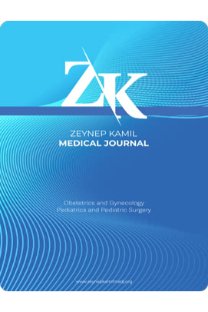Febrile seizures: Clinical features of 96 patients
Klinik bulgular, Nöbetler, febril, Çocuk, Araştırma teknikleri
Febrile seizures: Clinical features of 96 patients
Clinical findings, Seizures, Febrile, Child, Investigative Techniques,
___
- 1- Aicardi J: Epilepsy in children. New York:Raven Press, 1995; 212-219
- 2- Gökyiğit A, Çalışkan A. Febril konvülsiyon nedeniyle hastaneye getirilen ve profılaktik antiepileptik tedavi uygulanmayan 274 çocukta 10 yıl sonra epilepsi insidansı ve EEG bulguları. Tıp Fak Mecmuası 1990;53:l-7
- 3- Consensus Developmental Panel.: Febrile seizures: long term management of children with fever associated seizures. Pediatrics 1980;66:1009-12
- 4- Berg AT, Shinnar S: Complex febrile seizures
- Epilepsia 1996;37: 126-33
- 5- Berg AT, Shinnar S, Hauser A et al: A prospective study of recurrent febrile seizures. New Engl J Med. 1992;327:1122-7
- 6-Berg AT, Shinnar S, Hauser WA, et al: Predictors of recurrent febrile seizures:a metaanalytic review. J Pediatr 1990; 116:329-37
- 7-Theodore-WH; Bhatia-S; Hatta-J; Fazilat-S; DeCarli-C; Bookheimer-SY; Gaillard-WD. Hippocampal atrophy, epilepsy duration, and febrile seizures in patients with partial seizures. Neurology. 1999 ;52: 132-6
- 8- Hauser WA, Annegers F: Prognosis of children with febrile seizures. In:Advances in Epileptology. Ed.Wolf P, Dam M, Janz F, Dreifuss E. New York:Raven Press 1987; 155-58
- 9- van Stuijvenberg M; Steyerberg EW; Derksen Lubsen G; Moll HA. Temperature, age, and recurrence of febrile seizure. Arch-Pediatr- Adolesc-Med. 1998; 152: 1170-5
- 10-Forsgreen L, Sidenvall R, Blomquist K, et al: A prospective incidence study of febrile convulsions. Acta Pediatr Scand. 1990;79:550-57
- 11- Ellenberg JH, Nelson KB: Sample selection and natural history of disease: studies of febrile seizures. JAMA 1980;243:1337-40
- 12- Rich SS, Annegers JF, Hauser AW, Anderson VE: Complex segregation analysis of febrile convulsions. Am J.Hum Genet. 1987;41:249-57
- 13-Doose H, Maurer A. Seizure risk in offspring of individuals with a history of febrile convulsions. Eur J Pediatr 1997; 156:476-481
- 14- Kugler SL; Johnson WG. Genetics of the febrile seizure susceptibility trait. Brain Dev 1998 ; 20: 265-74 15- Nelson KB, Ellenberg JH. Prognosis in children with febrile seizures. Pediatrics. 1978;61:720-27
- ISSN: 1300-7971
- Yayın Aralığı: 4
- Başlangıç: 1969
- Yayıncı: Ali Cangül
Alpaslan APAN, Şermin UYGUN, Gülçin ERTÜRK
Bir heterotopik gebelik: olgu sunumu
Semih TUĞRUL, Şebnem İNAL, Özay ORAL, İlhan ŞANVERDİ
İnfantil spazm tanısı alan 16 olgunun retrospektif olarak değerlendirilmesi
Pulat Lale SEREN, Abdülkadir BOZAYKUT, N. SİPAHİER, S. KARAMAN
Doğum eylemine tıbbi yardım: Oxytocin kullanımı
Belgin DEVRANOĞLU, Oya PEKİN, Ayşe GÜRBÜZ, Ateş KARATEKE
Sema DEMİRBAŞOĞLU, Barış MÜLAYİM, Özay ORAL
Aile planlamasında sezaryen esnasında postplasental rahim içi araç uygulaması ve sonuçları
Semih TUĞRUL, Ayşe GÜRBÜZ, Özay ORAL, Gazi YILDIRIM, Toygun BAŞARAN
Olgu sunumu: Norplant ile görülen bir gebelik olgusu
Hastanemizdeki son 4 yıldaki zehirlenme vakalarının değerlendirilmesi
Müjgan ORAL, Özlem TEMEL, Gülşah GÜVEN, Tolga ERKUM, Arzu YAŞAROĞLU, Meral İNALHAN, Savaş İNAN
Olgu sunumu: Glioblastoma ile seyreden bir nöroblastom olgusu
Meral İNALHAN, Özlem TEMEL, Gülşah GÜVEN, Tolga ERKUM, Savaş İNAN
Febrile seizures: Clinical features of 96 patients
Yüksel YILMAZ, Berna ŞENER, Handan ŞAHSUVAROĞLU, ENVER ATAY, Meral İNALHAN, Savaş İNAN
